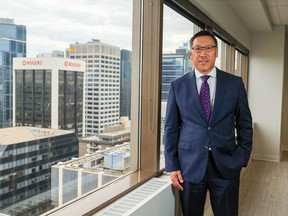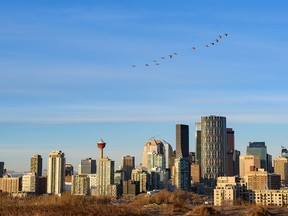Alberta's oil and gas industry struggling for entry-level workers during boom

Article content
At times this summer, CWC Energy Services has had 100 open jobs.
Company president and CEO Duncan Au says the Calgary-based oilfield servicing operation has been struggling with months of hiring challenges, and it’s far from the only one.
CWC has specifically been short on front-line labour — field crews who lay down pipe on service rigs that pump oil or natural gas, and then work onsite during the well’s lifespan before ultimately helping to decommission it. It’s the kind of entry-level work that’s long been a backbone of Alberta’s oil and gas industry — the potential for six-figure earnings with few formal qualifications has a history of attracting workers from across the country.
Au says there isn’t necessarily a lack of applicants for open jobs, but there have been other pitfalls in the hiring process. From no-shows to interviews to new hires that disappear after orientation to people who decide after a few shifts that long days of physical labour aren’t for them, keeping positions filled hasn’t been easy.
“It’s that bottom-level, entry-level position where we have difficulty filling, as does pretty much every one of my competitors in our industry,” Au said.
“What’s happening right now is that if you are desperate enough, you’re just going to go steal hands from your competitor by giving them more money. We saw that happen this past winter — guys were paying $7 an hour higher than what we were paying.”
Alberta’s oil and gas industry is no stranger to boom and bust cycles, and that’s always affected the labour force, too. But the past two years have been a different kind of roller coaster, from negative prices for a barrel of oil in April 2020 to the current surge in demand that’s seen prices march back up.
For companies like Au’s, cutting the workforce down to a fraction of normal at the start of the COVID-19 pandemic has them now struggling to return to full strength. As of May 1, CWC bumped the total compensation for a five-person service rig crew by 17 per cent.
“We’re hopeful that is going to help attract new people back into the industry again and help solve some of our labour challenges,” Au said.
Alberta unemployment rate spends summer at record low
Adverti
Article content
Alberta’s unemployment rate is low, most recently dropping to 4.9 per cent in June and July before jumping to 5.4 per cent in August, according to the latest Statistics Canada Labour Force survey. The July rate was the province’s lowest since 2015, but it has yet to officially drop below the 4.5 per cent threshold that Alberta uses to define a labour shortage.
University of Alberta economist Joseph Marchand says the story of Alberta labour shortages is industry-specific. According to the June statistics in the province’s economic dashboard, the unemployment rate for the mining, quarrying and oil and gas industry is just 1.6 per cent — the lowest across any of the industries tracked.
Unemployment in Alberta’s information, culture and recreation sector sits just slightly above that number, at 1.7 per cent, and the jobless rate in health care and social assistance is at two per cent.
Advertisement 5
Article content
There’s not necessarily a huge difference in how those numbers are playing out across the province, especially in Calgary and Edmonton. The need for more nurses and paramedics, for example, has been widely felt, but those problems have long been more acute in rural communities. Major tourist destinations like Banff have also borne the brunt of hotel staff shortages.
COVID-19 has had a severe impact in all those industries in different ways, and Marchand says there’s likely an element of “COVID hangover” that’s still at play.
Marchand has specifically studied how energy booms and busts have affected labour markets in Western Canada. But while signs point to another boom, it doesn’t quite look the same as in the past — and that affects the decisions workers are making, too.
Advertisement
“Think of any other times that it’s heated up — the papers would be hit with an announcement of this project and that project. I’ve seen one or two over the last two years, but really, you’re not seeing the big capital expenditure.”
Open positions higher than ever for parts of energy sector
According to Petroleum Services Association of Canada (PSAC) president and CEO Gurpreet Lail, an informal survey of PSAC’s members in the spring showed more than 2,000 vacant jobs.
“We’re higher than we’ve ever been before with open positions and not enough bodies,” she said.
She and others in the industry point to the high-profile conversation about climate change and the need for an energy transition as another factor in the struggle for workers.
Advertisement 7
Article content
“A lot of our young people were hearing there is no future for them (in oil and gas). And that’s not the case. We’re going to need oil and gas to evolve into new forms of energy, and we need people to come back into the sector.”
There’s also a long history of Alberta oil companies hiring workers from the Maritime provinces, and Au and others say the flow of labour into the West hasn’t returned to normal.
The “Atlantic bubble” in place during heightened parts of the pandemic prompted some workers who were away from home to go back East and stay there, and many haven’t returned. Whether the time away made them decide the fly-in, fly-out life was no longer for them or the prospect of dealing with beleaguered air travel just isn’t worth it, economic mobility in Canada has changed.
Advertisement 8
Article content
“We haven’t had a big recruiting effort into the east coast, as we’ve had, say, pre-recession years,” Au said.
“We continue to try and attract there, but we have heard from other competitors that their recruiting efforts there have gotten nada — they haven’t been successful.”
In July, Au said the company made strides to closing its employee gap, but they’re still trying to get more workers to stay once they’re through the door. Word of mouth is yielding some success, as well as referral bonuses for employees who bring in new hires.
“They have to believe that if they’re going to come back into this industry, that it’s going to be a multi-year run,” Au said.
“I think it’s going to be a longer run, and it’s a little different this time around because our oil and gas companies are much more disciplined than in past boom and bust cycles.”
Advertisement 9

Other job shortages across Alberta
Nurses: Alberta is expecting a shortage of registered nurses and registered psychiatric nurses over the next two years, according to the province’s job market forecast. Advocates have raised issues with nurses’ working conditions and pay across Canada for years, but COVID-19 exacerbated the issue, driving burnout that’s leading some nurses to retire earlier than planned or switch careers entirely.
Hotel staff: Hospitality was among the hardest-hit industries during the height of public-health restrictions to drive down COVID numbers. Business trips and leisure travel ground to a total halt, and hotels had to resort to mass layoffs. Some were rehired only to be laid off again during another COVID wave, and Alberta Hotel and Lodging Association president and CEO Dave Kaiser says as a result, the industry permanently lost a large portion of the workforce.
Advertisement
Article content
“Some folks just gave up with the perception of precarious employment, and they found jobs in other sectors as the economy was reopening,” he said. “And so now there’s a hole to fill.”
What other employers are saying about hiring challenges
Scott Tetz, president and founder of Sherwood Park-based Truck Part Solutions:
“It’s a really tough market for programmers. We have an IT position that’s been open for about a year … (We’ve changed) the wording of our job ads, kind of highlighting that impact that they could have in our company, and we’ve changed the way our interview process works as well. Obviously, with inflation, the wages are different, too.”
Step Energy Services president and COO Steve Glanville:
“We have a lot of heavy tractor-trailer units, trucks driving up and down the road. So the biggest holdup for us has been finding qualified Class 1 drivers. … We’ve been quite creative during this time and are looking at changing work schedules. In the past, it’s been kind of working for two weeks and having one week off. We’re looking at a bit more flexible schedules to get more time for a work-life balance perspective, as well as starting to recruit out in the East Coast.”
Sam Jenkins, managing partner at Edmonton-based software development company Punchcard Systems:
“We’ve been trying to hire development team leads for months. … I’m very, very grateful that we can hire from everywhere. That does make it a little bit easier for us. But I think that the actual truth behind all of this is that fundamentally, there are more jobs to be done than people who are in the industry, and this is a global talent shortage when it comes to the technical space.”
No comments:
Post a Comment